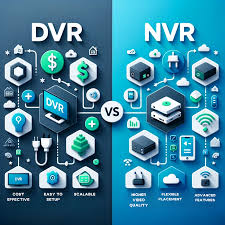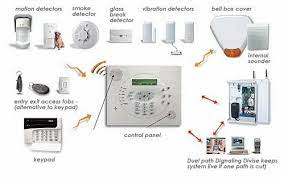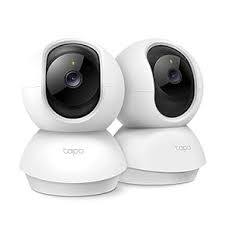When it comes to video surveillance systems, Digital Video Recorders (DVR) and Network Video Recorders (NVR) play a crucial role in capturing, storing, and managing security footage. Both DVR and NVR serve as the backbone of modern security setups, offering advanced features and functionalities to enhance monitoring and recording capabilities.
DVR:
A Digital Video Recorder is a device that records video footage from analog cameras onto a hard drive. DVR systems are commonly used in traditional CCTV setups where analog cameras are connected directly to the recorder using coaxial cables. DVRs encode and process video signals received from analog cameras before storing them on the internal hard drive for playback and review.
Key features of DVR systems include:
- Real-time recording: DVRs can capture video footage in real-time, allowing for immediate monitoring and playback.
- Remote access: Many DVR systems offer remote viewing capabilities, enabling users to access live or recorded footage from anywhere using a computer or mobile device.
- Motion detection: DVRs can be configured to detect motion within the camera’s field of view, triggering recordings when activity is detected.
- Storage capacity: The storage capacity of a DVR system depends on the size of the internal hard drive, allowing for days or weeks of continuous recording.
NVR:
A Network Video Recorder is designed to work with IP cameras that transmit digital video data over an Ethernet network. NVR systems receive video streams from IP cameras via the network and store recordings on a dedicated hard drive. NVRs offer scalability and flexibility, making them ideal for larger surveillance installations requiring multiple cameras.
Key features of NVR systems include:
- High-definition recording: NVRs support high-definition video resolutions offered by IP cameras, delivering crisp and clear footage.
- Remote access: Similar to DVRs, NVR systems allow users to remotely access live or recorded video feeds over the internet.
- Intelligent analytics: Some NVR models come equipped with advanced analytics capabilities such as facial recognition, object detection, and license plate recognition.
- PoE support: Many NVRs feature Power over Ethernet (PoE) ports that simplify camera installation by providing power and data connectivity over a single Ethernet cable.
In conclusion, both DVR and NVR systems play essential roles in modern video surveillance applications. While DVRs are well-suited for analog camera setups with coaxial connections, NVRs offer enhanced performance and flexibility for IP camera installations. Understanding the differences between these two technologies can help users choose the right solution based on their specific security needs and requirements.
Top 7 Frequently Asked Questions About DVR and NVR Systems
- What is the difference between a DVR and an NVR?
- Can I use analog cameras with an NVR system?
- How many cameras can be connected to a DVR/NVR?
- Do DVR/NVR systems support remote viewing?
- What is the storage capacity of a typical DVR/NVR?
- Are there any subscription fees for accessing recordings remotely?
- Do DVR/NVR systems offer motion detection capabilities?
What is the difference between a DVR and an NVR?
One of the most frequently asked questions in the realm of video surveillance is, “What is the difference between a DVR and an NVR?” The primary distinction lies in how they handle video data. A Digital Video Recorder (DVR) is designed for analog camera systems, where it encodes and processes video signals from analog cameras before storing them on a local hard drive. On the other hand, a Network Video Recorder (NVR) works with IP cameras that transmit digital video data over a network, allowing for high-definition recording and advanced analytics capabilities. While DVRs are best suited for traditional CCTV setups, NVRs offer scalability and flexibility for larger surveillance installations requiring multiple IP cameras.
Can I use analog cameras with an NVR system?
One of the frequently asked questions regarding NVR systems is whether analog cameras can be used with them. The answer to this question is generally no, as Network Video Recorders (NVRs) are specifically designed to work with IP cameras that transmit digital video data over an Ethernet network. Analog cameras, which use analog signals and connect directly to Digital Video Recorders (DVRs) via coaxial cables, are not compatible with NVR systems. To utilize analog cameras in a surveillance setup, a DVR would be the more suitable choice due to its compatibility with analog camera technology. It’s important for users to consider the type of cameras they have or plan to use when selecting between DVR and NVR systems to ensure seamless integration and optimal performance.
How many cameras can be connected to a DVR/NVR?
One of the frequently asked questions regarding DVR and NVR systems is about the number of cameras that can be connected to them. The answer to this question varies depending on the specific model and capabilities of the DVR or NVR. In general, DVR systems designed for analog cameras typically support a fixed number of camera inputs, often ranging from 4 to 16 channels. On the other hand, NVR systems used with IP cameras offer greater scalability and flexibility, allowing users to connect a larger number of cameras based on the available network bandwidth and storage capacity. It is essential for users to check the specifications of their chosen DVR or NVR system to determine the maximum number of cameras that can be connected for optimal performance and surveillance coverage.
Do DVR/NVR systems support remote viewing?
Yes, both DVR and NVR systems support remote viewing, allowing users to access live or recorded video footage from anywhere using a computer, smartphone, or tablet. Remote viewing functionality is a key feature of modern surveillance systems, providing users with the flexibility to monitor their premises in real-time or review past recordings remotely. By connecting the DVR/NVR system to the internet and configuring the appropriate settings, users can securely access their cameras and recordings over the network, enhancing convenience and peace of mind for monitoring security and surveillance activities even when away from the physical location.
What is the storage capacity of a typical DVR/NVR?
The storage capacity of a typical DVR or NVR system varies depending on several factors, including the number of cameras connected, the video resolution and quality settings, and the retention period required for storing footage. Generally, DVR systems equipped with internal hard drives can offer storage capacities ranging from a few hundred gigabytes to several terabytes. On the other hand, NVR systems designed for IP cameras often provide higher storage capacities to accommodate the larger file sizes of high-definition video streams. Users can also expand the storage capacity of both DVR and NVR systems by adding external hard drives or connecting to network-attached storage (NAS) devices for increased recording space. It is essential to consider factors like camera resolution, frame rate, and recording duration when determining the appropriate storage capacity needed for effective video surveillance operations.
Are there any subscription fees for accessing recordings remotely?
One common concern that users often have when considering remote access to DVR and NVR recordings is whether there are any subscription fees involved. The answer to this question typically depends on the specific brand and model of the surveillance system being used. Some manufacturers offer free remote access features as part of their product package, allowing users to view live or recorded footage without any additional charges. However, certain advanced functionalities or cloud storage options may require a subscription fee for extended services such as longer data retention periods, enhanced analytics, or remote management capabilities. It is advisable for users to carefully review the product specifications and terms of service to determine if any subscription fees apply for accessing recordings remotely.
Do DVR/NVR systems offer motion detection capabilities?
Yes, both DVR and NVR systems commonly offer motion detection capabilities as a key feature. Motion detection technology allows the surveillance system to identify movement within the camera’s field of view, triggering recording or alerts when activity is detected. This feature is particularly useful for conserving storage space by only recording when motion is detected, as well as for enhancing security by alerting users to potential threats or suspicious behavior. Users can customize motion detection settings on their DVR or NVR systems to adjust sensitivity levels, define specific areas of interest, and set up notifications for real-time monitoring of events. Overall, motion detection is a valuable tool in maximizing the efficiency and effectiveness of video surveillance systems.



